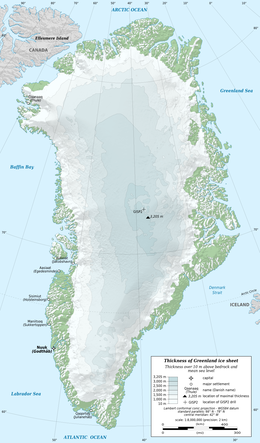Geography of Greenland
| Native name: Kalaallit Nunaat Grønland Greenland |
|
|---|---|

Outline map of Greenland with ice sheet depths. (Note that much of the area in green has permanent snow cover, but less than 10m (33ft) thick.)
|
|
| Geography | |
| Location | between the Arctic Ocean and the North Atlantic Ocean |
| Coordinates | 64°10′N 51°43′W / 64.167°N 51.717°W |
| Area | 2,166,086 km2 (836,330 sq mi) |
| Area rank | 1st |
| Coastline | 44,087 km (27,394.4 mi) |
| Highest elevation | 3,694 m (12,119 ft) |
| Highest point | Gunnbjørn |
| Administration | |
|
Denmark
|
|
| Province | Greenland |
| Largest settlement | Nuuk (Godthåb) (pop. 15,047) |
| Demographics | |
| Population | 56,344 (2007) |
| Pop. density | 0.026 /km2 (0.067 /sq mi) |
| Ethnic groups | 88% (Inuit and Inuit-Danish mixed ), 12% Europeans, mostly Danish. |
Greenland is located between the Arctic Ocean and the North Atlantic Ocean, northeast of Canada and northwest of Iceland. The territory comprises the island of Greenland–the largest island in the world–and more than a hundred other smaller islands (see alphabetic list). As an island, Greenland has no land boundaries and 44,087 km of coastline. A sparse population is confined to small settlements along certain sectors of the coast. Greenland possesses the world's second largest ice sheet.
Greenland sits atop the Greenland plate, a subplate of the North American plate. The Greenland craton is made up of some of the oldest rocks on the face of the earth. The Isua greenstone belt in southwestern Greenland contains the oldest known rocks on Earth, dated at 3.7–3.8 billion years old.
The vegetation is generally sparse, with the only patch of forested land being found in Nanortalik Municipality in the extreme south near Cape Farewell.
The climate is arctic to subarctic, with cool summers and cold winters. The terrain is mostly a flat but gradually sloping icecap that covers all land except for a narrow, mountainous, barren, rocky coast. The lowest elevation is sea level and the highest elevation is the summit of Gunnbjørn Fjeld, the highest point in the Arctic at 3,694 meters (12,119 ft). The northernmost point of the Island of Greenland is Cape Morris Jesup, discovered by Admiral Robert Peary in 1909. Natural resources include zinc, lead, iron ore, coal, molybdenum, gold, platinum, uranium, hydropower and fish.
...
Wikipedia
